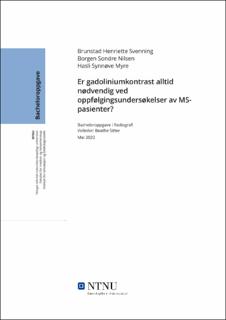| dc.contributor.advisor | Sitter, Beathe | |
| dc.contributor.author | Brunstad, Henriette Svenning | |
| dc.contributor.author | Borgen, Sondre Nilsen | |
| dc.contributor.author | Hasli, Synnøve Myre | |
| dc.date.accessioned | 2022-07-12T17:21:12Z | |
| dc.date.available | 2022-07-12T17:21:12Z | |
| dc.date.issued | 2022 | |
| dc.identifier | no.ntnu:inspera:110850715:111763980 | |
| dc.identifier.uri | https://hdl.handle.net/11250/3004876 | |
| dc.description.abstract | Innledning: Pasienter med Multippel sklerose (MS) er en pasientgruppe som undersøkes med MR både med og uten gadolinium (Gd) kontrastvæske, ved diagnostisering, etter 3-6 mnd og deretter årlig. Kontrastmiddelet brukes til å fremstille aktiv inflammasjon og følge behandlingsrespons. European Medicines Agency (EMA) har anbefalt restriksjoner hovedsakelig ved bruk av lineære kontrastmidler på bakgrunn av gadoliniumsavleiringer i hjernevev. Double Inversion Recovery (DIR) og Fluid Attenuated Inversion Recovery (FLAIR) er sekvenser som benyttes uten kontrastmiddel, der DIR undertrykker både fett- og væskeholdig vev, mens FLAIR undertrykker signal fra væske. Dermed vil resterende vev som i utgangspunktet har lik signalintensitet, få større kontrastforskjeller. Hensikten med denne studien var å undersøke hvilken diagnostisk nytte Gd-kontrast har ved oppfølgingsundersøkelser av MS-pasienter.
Metode: Vi utførte en litteraturstudie med systematiske søk i databasene Oria, SCOPUS og Pubmed. Vi gjennomførte 15 søk med en kombinasjon av 8 ulike søkeord. Det ble funnet artikler i 8 av søkene. Etter filtrering med inklusjons- og eksklusjonskriterier ble totalt 9 unike artikler inkludert.
Resultat: I gjennomsnitt 79% (75,8-86,3%) av pasientene kunne blitt undersøkt uten kontrast ved å basere kontrastadministrasjon på lesjonsaktivitet fra DIR og/eller FLAIR. Det var kun to studier som påviste kontrastladende lesjoner blant pasienter som ikke viste en forverring på MR-opptak uten Gd-kontrast. Resterende artikler fant ingen kontrastladende lesjoner uten korrelasjon til nye eller forstørrede lesjoner basert på MR-opptakene uten kontrast på DIR og FLAIR. Flere kontrastladende lesjoner ble også påvist på MR-opptak uten kontrast. Der DIR i de fleste tilfellene påviste flere lesjoner sammenlignet med FLAIR og T2-TSE.
Konklusjon: Dersom pasientene er medikamentelt og klinisk stabile, og uten økt lesjonsaktivitet, vil ikke Gd-kontrast bidra med særlig stor diagnostisk nytte. DIR vil kunne være en god supplerende metode for måling av lesjonsaktivitet på MS-pasienter. | |
| dc.description.abstract | Introduction: Multiple Sclerosis (MS) patients undergoes MRI examinations with and without Gadolinium-based contrast agents (GBCAs) regularly, at diagnosis, after 3-6 months and then annually. GBCAs are used to show active inflammation and follow treatment response. European Medicines Agency (EMA) has recommended restrictions mainly on the use of linear contrast agents, based on Gd deposits in the brain tissue. Double Inversion Recovery (DIR) and Fluid Attenuated Inversion Recovery (FLAIR) are sequences that doesn't use GBCAs. DIR supresses tissue with both fat and liquid, and FLAIR supresses signal from liquid. Thus, the remaining tissues which in principle have the same signal intensity will achieve greater contrast differences. The purpose of this study was to examine the diagnostic value of GBCAs in follow-up examinations of MS-patients.
Method: We performed a literature study with systematic searches in the databases Oria, Scopus and Pubmed. We conducted 15 searches with a combination of 8 different keywords. We found articles in 8 of the searches. After filtering with inclusion and exclusion criteria, a total of 9 unique articles where included.
Results: An average of 79% (75,8-86,3%) of patients could be examined without GBCAs by basing contrast administration on lesion activity from DIR and/or FLAIR. There were only two studies that showed contrast enhanced lesions (CEL) without correlation to new or enlarged lesions from unenhanced images. The remaining articles found no CELs without correlation to new or enlarged lesions from unenhanced images. Several CELs were also detected on the unenhanced images. Where DIR in most cases detected more lesions compared to FLAIR and T2-TSE.
Conclusion: If the patients are medically and clinically stable, and does not show an increase in lesion activity, GBCAs will not contribute with much diagnostic benefit. DIR could be a good supplementary method for measuring lesion activity in MS-patients. | |
| dc.language | nob | |
| dc.publisher | NTNU | |
| dc.title | Er gadoliniumkontrast alltid nødvendig ved oppfølgingsundersøkelser av MS-pasienter? | |
| dc.type | Bachelor thesis | |
